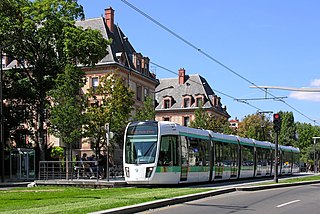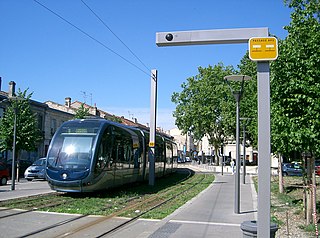
The RATP Group, also known as the Régie Autonome des Transports Parisiens, is a state-owned public transport operator and maintainer headquartered in Paris, France. Formed in 1949, it has its origins as the city's public transport operator. Its logo represents, in a stylized version, the Seine's meandering through the Paris area as the face of a person looking up.

A tram-train is a light-rail public transport system where trams run through from an urban tramway network to main-line railway lines which are shared with conventional trains. This combines the tram's flexibility and accessibility with a train's greater speed, and bridges the distance between main railway stations and a city centre.
Keolis is a Franco-Québécois private operator of public transport. The company manages bus, metro, tramways and coach networks, rental bikes, car parks, boat shuttles, cable cars, trolleybuses and airport services.

The Île-de-France tramways consists of a network of modern tram lines in the Île-de-France region of France. Ten lines are currently operational, with extensions and additional lines in the planning and construction stage. Although the system mainly runs in the suburban regions of Paris, lines T3a and T3b run entirely within Paris city limits, and line T2 also does so for part of its route. While the lines operate independently of each other and are generally unconnected, some connections do exist: between lines T2 and T3a, T3a and T3b, T1 and T5, T1 and T8 and T8 and T11 Express. However, the final design of the entire planned tram network is fairly integrated.

The Bordeaux tramway network consists of three lines serving the city of Bordeaux in Aquitaine in southwestern France.

Le Havre tramway is a modern two-line tram system in the city of Le Havre in Normandy, France. The modern tramway opened on 12 December 2012.

The Marseille tramway is a tramway system in the French city of Marseille in Provence-Alpes-Côte d'Azur. Marseille's modern tram network now consists of three lines, serving 32 stations, and operating over 15.8 kilometres (9.8 mi) of route. The current, modern Marseille tram network opened on 7 July 2007.

The Strasbourg tramway, run by the CTS, is a network of six tramlines, A, B, C, D, E and F that operate in the city of Strasbourg in Alsace, France and Kehl in Baden-Württemberg, Germany. The first tramline in Strasbourg, which was originally horse-drawn, opened in 1878. After 1894, when an electric powered tram system was introduced, a widespread network of tramways was built, including several longer distance lines on both sides of the Rhine. The decline of the tramways system began in the 1930s, and ended with the retirement of the service in 1960 in parallel to the closure of many such systems in France and the rest of the Western world. However, a strategic reconsideration of the city's public transport requirements led to the reconstruction of the system, a development whose success led to other large French cities reopening their tramways, such as Montpellier and Nice. Lines A and D were opened in 1994, lines B and C were opened in 2000, line E was opened in 2007 and line F was opened in 2010. It is regarded as a remarkable example of the tramway's rebirth in the 1990s. Together with the success seen in Nantes since 1985, the Strasbourg experiment resulted in the construction of tramways in multiple other French urban areas, and the expansion of tramway systems remains an ongoing project in Strasbourg and throughout France.

Île-de-France tramway Line 1 is part of the modern tram network of the Île-de-France region of France. Line T1 connects Noisy-le-Sec station and Les Courtilles with a suburban alignment running in parallel to the Northern city limits of Paris. The line has a length of 17 km (11 mi) and 36 stations. It opened in 1992 as the first modern tram line in the Paris region. The line was extended in December 2003 and November 2012.

Rail transport in Morocco is operated by the national railway operator ONCF. It was initially developed during the colonial era.

The Dubai Tram is a tramway located in Al Sufouh, Dubai, United Arab Emirates. It runs for 14.5 kilometers (9.0 mi) along Al Sufouh Road from Dubai Marina to the Palm Jumeirah and Al Sufouh. The tram interchanges with Jumeirah Lakes Towers Station and Dubai Marina Station of the Dubai Metro's Red Line and two more metro station are expected to connect with the tram in the future. The Dubai Tram is also connected with the monorail of the Palm Jumeirah at the entrance of the Palm from Sufouh Road.

The Casablanca Tramway is a low-floor tram system in Casablanca, Morocco. It is the second tram system in Morocco, after the Rabat-Salé tramway, but is longer and has more stations. As of 2017, it consists of one 31 kilometre Y-shaped line with 48 stops, connecting Sidi Moumen in the east with Ain Diab and the Facultés district in the west. A 22 kilometre extension is scheduled to open in 2018 with more lines planned.

The Algiers Tramway is a tram system which commenced service on May 8, 2011 on part of the yet to be fully completed line in the Algerian capital, Algiers. By June 2012, the opened sections had a length of 16.2 kilometres (10.1 mi) and 28 stops and were operated by ETUSA, the public transport operator for the Algiers metropolitan area, using Alstom Citadis trams. An extension, to take the tramway to a total length of 23.2 kilometres (14.4 mi), is currently (2013) under construction.

Philippe Neerman (1930–2011) was a Belgian industrial designer and President of Industrial Design Planning Office Philippe Neerman & Co. N.V.\S.A. He was known for his application of ergonomics in public transportation systems and his work on major projects such as the Royal Library of Belgium, the Royal Castle of Laeken, and the Royal Palace of Brussels. He also participated in the international Design Biennale Interieur in Courtray, Belgium. He mainly focused on transportation and made designs for metros and trams including the Euro Tram, the Brussels Metro, and the Metro in Barcelona. His work has been incorporated into a diverse collection of museums, including the Ghent Design Museum.

The Clermont-Ferrand tramway is a transit system located in the city of Clermont-Ferrand in the Auvergne-Rhône-Alpes region of France. It is a Translohr system, meaning it is guided by a single rail and powered by electricity from overhead wires.

Trams in Liège, Belgium, date back to 1871 which is when the first tramcars using rail tracks and powered by horse traction were introduced in the city. The number and variety of horse-trams proliferated.

The Ayacucho Tram is a Translohr tram system that serves the Metropolitan Area of the Aburrá Valley in Medellín, Antioquia, Colombia. It started trial operations on 20 October 2015. The tramline consists of 9 stations with three of those allowing interchanges with the Medellín Metro and the Metrocable systems. The Ayacucho Tram is operated by Medellín Metro and is the only tram in Colombia.
![Public transport shared transport[ation] service that is available for use by the general public; usually of passengers but sometimes of goods](https://upload.wikimedia.org/wikipedia/commons/thumb/0/0b/R160A_E_Train_entering_World_Trade_Center.jpg/320px-R160A_E_Train_entering_World_Trade_Center.jpg)


















